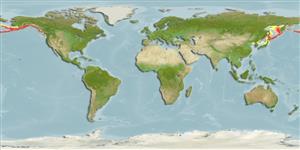Environment: milieu / climate zone / depth range / distribution range
Ecología
marino batidemersal; rango de profundidad 25 - 925 m (Ref. 6793), usually 100 - 380 m. Deep-water; 61°N - 37°N
North Pacific: Sea of Japan to the Bering Sea and southeastern Alaska.
Tamaño / Peso / Age
Maturity: Lm ? range ? - ? cm
Max length : 26.0 cm TL macho / no sexado; (Ref. 7297); 30.8 cm SL (female); common length : 16.0 cm TL macho / no sexado; (Ref. 2850); edad máxima reportada: 8 años (Ref. 122394)
Espinas dorsales (total): 10 - 12; Radios blandos dorsales (total): 21-23; Espinas anales 0; Radios blandos anales: 20 - 24. Eye large, orbital diameter 1.5 times snout length; maxillary with small ctenoid scales (Ref. 559).
Commonly between 100 and 380 m on mud, sand, pebbles, gravel and shell.
Life cycle and mating behavior
Madurez | Reproducción | Puesta | Huevos | Fecundidad | Larva
Pietsch, T.W., 1993. Systematics and distribution of cottid fishes of the genus Triglops Reinhardt (Teleostei: Scorpaeniformes). Zool. J. Linn. Soc. 109:335-393. (Ref. 7297)
IUCN Red List Status (Ref. 130435)
Threat to humans
Harmless
Human uses
Pesquerías: sin interés
Más información
ReferenciasAcuiculturaPerfil de acuiculturaRazasGenéticaElectrophoresesheritabilidadEnfermedadesProcesamientoNutrientsMass conversion
ColaboradoresImágenesStamps, Coins Misc.SonidosCiguateraVelocidadTipo de nataciónSuperficie branquialOtolitosCerebrosVisión
Herramientas
Special reports
Download XML
Fuentes de Internet
Estimates based on models
Preferred temperature (Ref.
123201): 0.9 - 5.9, mean 3.7 °C (based on 238 cells).
Phylogenetic diversity index (Ref.
82804): PD
50 = 0.5010 [Uniqueness, from 0.5 = low to 2.0 = high].
Bayesian length-weight: a=0.00589 (0.00350 - 0.00989), b=3.20 (3.05 - 3.35), in cm total length, based on LWR estimates for this species & (Sub)family-body (Ref.
93245).
Nivel trófico (Ref.
69278): 3.2 ±0.3 se; based on diet studies.
Generation time: 10.0 ( na - na) years. Estimated as median ln(3)/K based on 1
growth studies.
Resiliencia (Ref.
120179): Muy bajo, población duplicada en un tiempo mínimo superior a 14 años (Preliminary K or Fecundity.).
Fishing Vulnerability (Ref.
59153): High vulnerability (61 of 100).
